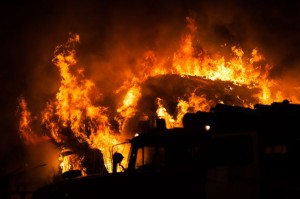Burning Black Churches and the Haze of Euphemism

“The vehicle you will see has a very distinct front license plate.” Those were the words used by Charleston police Chief Gregory Mullen in his initial statement to the press on June 18, the morning after Dylann Roof slaughtered nine black individuals in a South Carolina church. And indeed, the license plate on Roof’s car was very distinct, most noticeably in its proud portrayal of three of the historical incarnations of the Confederate flag. It’s speculation on my part, but I have to believe—given the eyewitness testimony, and given the clarity of the surveillance images pulled from the church’s cameras—that Chief Mullen knew as much. And if he did know as much, why didn’t he say it? Perhaps more to the point: should he have?
Nobody can know for sure what information Mullen had or what his motivations may have been, so I won’t dwell there. I reference his language only in an attempt to force a discussion about other questions—to suggest that the possibly deliberate substitution of “very distinct” for “Confederate flag” is symptomatic of a larger problem in a US media that continually employs euphemistic and evasive language in any and all discussions about race.
In the weeks since Dylann Roof committed his racially motivated massacre, seven predominantly black churches across the South and one Latino church in California have been burned to the ground. Of those fires, three are known to have been set intentionally and two may have been caused by lightning strikes—what caused the last three remains unknown. But in reading the news on the subject you would never guess at the uncertainty of the investigation or the implications of the crimes; all sources, it seems, are competing against each other in a race to use the most non-urgent and delicate language they can conjure.
A July 2 headline from the New York Times reads like this: “Lightning Believed Cause of Fire at Black Church.” This was in response to the seventh black church that had burned in the previous ten days. Why not, instead, “At Least Two of the Recent Black Church Fires Set Intentionally”? It’s a failure to contextualize the violence done against black communities—the fault of a media pretending that each act of racially-motivated violence is new and surprising even though it’s neither.
CNN had the perverse and mind-numbing audacity to ask, defensively: “Why Are Black Church Fires Associated with Acts of Hate?”—a question so insultingly ignorant of history that it’s almost not worth engaging. A recent headline on Yahoo! declares with authority: “No racial motivation in US church fires: official,” despite the fact that all investigations are still open and ongoing. Other headlines and articles oscillate between aggressive deflection, pre-emptive dismissal, and insipid indifference. Nobody quite understands the urgency—and nobody quite cares to.
The tendency is to ignore history, to ignore context, and to urge instead the “lack of evidence” that might suggest a hate crime—though it seems, to me, that the deliberate burning of a predominantly black church would itself constitute the evidence. The New York Times article, after noting that investigators had found no evidence of hate crimes, even in the two cases of arson, continues:
“Despite such assurances, the fires have sent a chill through black congregations that are well aware of a long history of their churches being targeted for violence by racists.”
This is a kind of tacit condescension; it dismisses the violence against black communities by supposing the illegitimacy of their concerns in the face of a paternalistic authority. Why are we not all aware of this long history? Why must awareness be confined to the victimized? But it’s not just history, it’s now—and the kind of ahistorical language used by the media ignores the current context in which these fires are occurring. It ignores the post-Charleston recruitment push by a KKK that openly celebrates Roof’s “victory.” It ignores that two of the intentionally set fires have occurred in states where the KKK recently passed out post-Charleston recruitment propaganda. It ignores that some of the burning churches have burned before, and that black churches have been alight with the fire of racists for decades. Bobby Jones, pastor of the now-destroyed Glover Grove Baptist Church (noticeably located in the same state where Roof committed his act of terror), said that until the day it burned, he’d often find “KKK” written across the outside walls of his church. And still, in another article last week the New York Times proclaimed: “No Evidence of Hate Crimes in Fires at Black Churches.”
Let me be clear, however, that to allege some kind of deliberate, large-scale media cover-up is intellectually irresponsible—that is not my intention. And as our readership surely knows, correlation does not always equal causation. It could very well be that, given the staggering number of church fires that occur in the United States weekly, the eight fires we’re discussing here just happen to fit post hoc into a currently thriving cultural narrative. It could be that a few of the eight were indeed caused by lightning strikes and a slew of faulty wirings. It could be that authorities and news sources are purposefully dancing around the issue to avoid the creation of further emotional stress and societal panic.
I mean only to suggest that, intent aside, the rhetorical dismissal of violence against minority communities can—and often has—manifested as a real, tangible dismissal of those communities, and the constant avoidance of national anxiety in regards to race only weakens our ability to eventually deal with it. Maybe now is the time—when black churches are catching fire across the South against a backdrop of racial terrorism, KKK resurgency, and Civil War-era ideological conflicts—that we explore the reality of racism instead of ignoring it.
